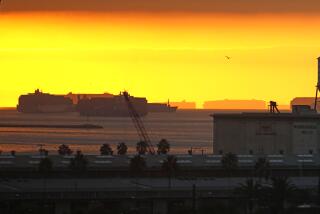Coast Guard’s Oil Tanker Tracking Safe, Officer Says
ANCHORAGE — Coast Guard personnel ceased physically plotting the movement of ships in the area where the Exxon Valdez ran aground after a new radar system was installed in 1984, the Coast Guard commander in Valdez testified Saturday.
But Cmdr. Steven McCall told federal investigators that the change, and a reduction in staff three years later, would not have compromised safety for tanker traffic at the site of the nation’s worst oil spill.
McCall made his statements on the fifth and final day of a National Transportation Safety Board hearing on the March 24 grounding of the 987-foot Exxon tanker in Prince William Sound.
The Coast Guard’s ability to monitor traffic in the sound has come under scrutiny since the ship spilled about 11 million gallons of North Slope crude oil.
Safety board officials, who heard earlier last week from Exxon representatives, some tanker crew members, state officials and others, have said they will not complete their report for several months.
McCall said the new radar system has functions that make it unnecessary to physically plot ship movements. He said the Coast Guard traffic station in Valdez had some staff cuts in 1987 and some duties were reassigned, but it did not pose any major problems.
Ship monitors testified last week that they could not see the Exxon tanker on radar in the minutes before it ran aground and had no indication that it was in trouble.
McCall said the radar system has a range of up to 20 miles, but the range varies with the weather.
McCall also confirmed that the tanker did not have the Coast Guard’s permission to leave normal traffic lanes. Normally, a tanker’s crew is supposed to ask for such permission. Members of the ship’s crew have said they left the lanes to avoid ice, and acknowledged that permission had not been asked.
In other testimony Saturday, McCall said there was no reason for him to take over response to the Exxon oil spill soon after it happened, because resources to deal with the spill were not on hand.
“There was no benefit to be derived from me taking it over,” he said. Response immediately after the accident was handled by Alyeska Pipeline Service Co., an industry consortium that manages the trans-Alaska oil pipeline and Valdez marine terminal.
McCall said that the use of oil-dispersing chemicals was discussed soon after the accident occurred. But he told investigators that Alyeska had in stock less dispersant than would have been needed to significantly reduce damage caused by the spill.
More to Read
Sign up for Essential California
The most important California stories and recommendations in your inbox every morning.
You may occasionally receive promotional content from the Los Angeles Times.










